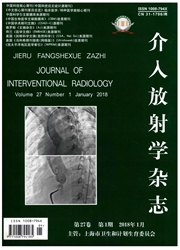

 中文摘要:
中文摘要:
目的评估无对比剂3.0T磁共振血管造影术(MRA)对蛛网膜下腔出血患者诊断和治疗的临床价值。方法对165例蛛网膜下腔出血患者在数字减影血管造影术(DSA)前行三维时间飞越法磁共振血管造影术(3D—TOF—MRA)检查。对每枚动脉瘤,用3D.TOF—MRA决定患者适合的治疗方法.包括经或不经球囊/支架辅助的弹簧圈栓塞治疗、外科夹闭、保守治疗。3D—TOF—MRA术前治疗计划与DSA最终决策的动脉瘤实际治疗方式相比较判定其临床治疗价值。结果以动脉瘤为基础评估对颅内动脉瘤检测的准确性为96.9%,敏感度为97.6%,特异度为93.1%,阳性预测值(PPV)为98.8%,阴性预测值(NPV)为87.1%。依椐3D—TOF—MRA工作位上动脉瘤的解剖特点可以准确地制定术前治疗计划,其准确性、敏感度、特异度、阳性预测值、阴性预测值分别为94.9%、94.0%、100%、100%、74.4%。结论无对比剂3D—TOF-MRA在检测颅内破裂动脉瘤方面具有较高的诊断准确性,并且可以有效、准确地制定适合的动脉瘤术前治疗计划。
 英文摘要:
英文摘要:
Objective To assess the clinical value of contrast-free magnetic resonance angiography (MRA) at 3.0T in making the diagnosis and therapeutic scheme of subarachnoid haemorrhage (SAH). Methods A total of 165 patients with SAH were enrolled in this study. 3D time-of-flight (TOF) MRA was performed before digital subtraction angiography (DSA) was carried out in all patients. For each aneurysm, 3D-TOF-MRA was used to determine whether the aneurysm was suitable for coil placement together with or not with balloon/stent-assisted coiling, or surgical clipping, or conservative treatment. Preoperative treatment planning based on 3D-TOF-MRA findings was compared with the final treatment decision based on DSA findings, and its clinical therapeutic value was evaluated. Results Each aneurysm was assessed individually. Based on the evaluation of each aneurysm, the accuracy, sensitivity and specificity of the detection of intracranial aneurysm were 96.9%, 97.6% and 93.1%, respectively. The positive predictive value (PPV) was 98.8% and negative predictive value (NPV) was 87.1%. With the help of the aneurysm anatomy displayed on volume rendering(VR) 3D-TOF-MRA, the treatment planning could be correctly made with the accuracy, sensitivity, specificity, PPV and NPV of 94.9%, 94.0%, 100%, 100% and 74.4%, respectively. Conclusion VR 3D-TOF-MRA offers high diagnostic accuracy for the detection of ruptured intracranial aneurysms, and it appears to be an effective tool that can be used for making the treatment scheme in most patients with SAH. (J Intervent Radiol, 2012, 21: 711-717)
 同期刊论文项目
同期刊论文项目
 同项目期刊论文
同项目期刊论文
 Comparison of percutaneous vertebroplasty with and without interventional tumour removal for maligna
Comparison of percutaneous vertebroplasty with and without interventional tumour removal for maligna Interventional tumor removal: a new technique for malignant spinal tumor and malignant vertebral com
Interventional tumor removal: a new technique for malignant spinal tumor and malignant vertebral com Evaluation of intracranial aneurysms with high-resolution MR angiography using single-artery highlig
Evaluation of intracranial aneurysms with high-resolution MR angiography using single-artery highlig Prevalence of Unruptured Cerebral Aneurysms in Chinese Adults Aged 35 to 75 Years: A Cross-sectional
Prevalence of Unruptured Cerebral Aneurysms in Chinese Adults Aged 35 to 75 Years: A Cross-sectional Safety and Efficacy of Percutaneous Vertebroplasty and Interventional Tumor Removal for Metastatic S
Safety and Efficacy of Percutaneous Vertebroplasty and Interventional Tumor Removal for Metastatic S 期刊信息
期刊信息
